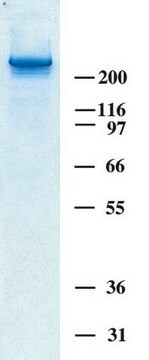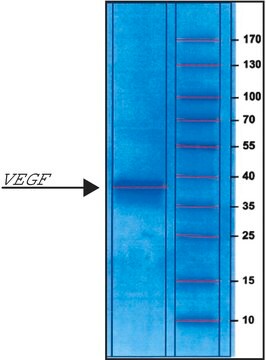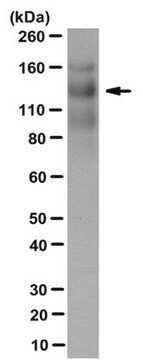ECM002
Thrombospondin-1 human
recombinant, expressed in HEK 293 cells, lyophilized powder, suitable for cell culture
Sinónimos:
THBS, THBS1, TSP, TSP1, Thrombospondin-1
About This Item
Productos recomendados
biological source
human
Quality Level
recombinant
expressed in HEK 293 cells
sterility
sterile
assay
≥95% (SDS-PAGE)
form
lyophilized powder
mol wt
127.5 kDa (The protein migrates as a 140 kDa band on SDS-PAGE due to glycosylation.)
packaging
pkg of 50 μg
technique(s)
cell culture | mammalian: suitable
impurities
≤1 EU/μg endotoxin, tested
solubility
water: soluble
NCBI accession no.
UniProt accession no.
shipped in
dry ice
storage temp.
−20°C
Gene Information
human ... THBS1(7057)
General description
Application
- To treat hepatocyte (IHH) cancer cells to study the role of aspartyl protease 1 (MfSAP1) in extracellular matrix degradation.
- In in vitro Extracellular Matrix (ECM) protein degradation assays.
- In rat C6 astroglioma cells, for coating the cell culture plates to study the effects of integrins on CNTF (ciliary neurotrophic factor) expression.
- In the preparation of secreted factor cocktail for analysis of the human mesenchymal stem cell secretome.
Recommended for use as a cell culture substratum at 1-5 μg/cm2 or 0.1-25 μg/ml. Optimal concentration depends on cell type as well as the application or research objectives.
Biochem/physiol Actions
Features and Benefits
- Human-derived thrombospondin
- Produced through recombinant expression in HEK 293 cells
- Low endotoxin levels
Physical form
Analysis Note
Storage Class
11 - Combustible Solids
wgk_germany
WGK 2
flash_point_f
Not applicable
flash_point_c
Not applicable
Elija entre una de las versiones más recientes:
Certificados de análisis (COA)
¿No ve la versión correcta?
Si necesita una versión concreta, puede buscar un certificado específico por el número de lote.
¿Ya tiene este producto?
Encuentre la documentación para los productos que ha comprado recientemente en la Biblioteca de documentos.
Artículos
Attachment Factors for 3-Dimensional Cell Culture
The extracellular matrix (ECM) is secreted by cells and surrounds them in tissues.
Nuestro equipo de científicos tiene experiencia en todas las áreas de investigación: Ciencias de la vida, Ciencia de los materiales, Síntesis química, Cromatografía, Analítica y muchas otras.
Póngase en contacto con el Servicio técnico






